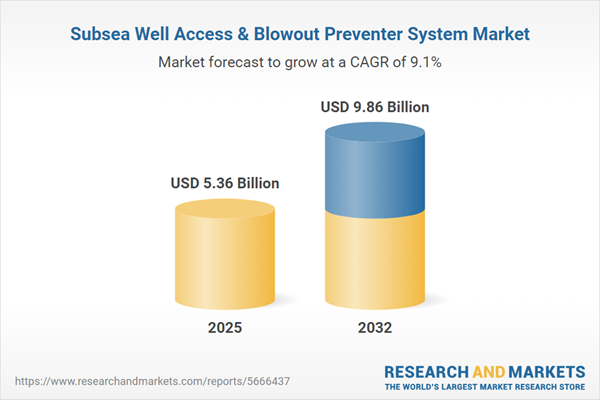Speak directly to the analyst to clarify any post sales queries you may have.
The subsea well access and blowout preventer system market is entering a transformative period as offshore operators re-align their approaches to meet new safety, compliance, and operational optimization standards. Today’s energy leaders are prioritizing robust technology strategies to balance regulatory requirements, cost control, and high-performance expectations across diverse geographies.
Market Snapshot: Global Subsea Well Access & Blowout Preventer System Market
The global subsea well access and blowout preventer system market is projected to grow from USD 4.92 billion in 2024 to USD 5.36 billion in 2025, with expectations to reach USD 9.86 billion by 2032. This expansion, anchored by a 9.06% CAGR, is driven by the rapid integration of digital solutions, strengthened safety protocols, and sustained investment in evolving offshore assets. The market’s direction is shaped by a combination of regulatory advancements, more rigorous project standards, and the mounting need for reliable asset performance in complex environments. Senior executives face a dynamic context where decisions about technology selection, compliance management, and lifecycle optimization will influence enterprise value and long-term competitive standing.
Scope & Segmentation
- Equipment Types: Annular and ram blowout preventers lead in ensuring subsea well safety, providing a critical line of defense and operational continuity during the key phases of drilling, completion, and ongoing maintenance. These components are essential for managing integrity in high-risk fields.
- Applications: Solutions designed for drilling, completion, and workover improve operational flexibility and support adaptation to dynamic well conditions throughout project timelines.
- Actuation Types: Electric, electrohydraulic, and hydraulic actuation systems address the requirements of challenging subsea scenarios, allowing responsive and resilient equipment control in variable marine environments.
- Water Depths: System families span shallow water, deep water, and ultra deep water deployments, extending asset lifespan and supporting a mix of mature field and greenfield developments worldwide.
- Pressure Classes: Adopting standardized pressure classes such as 5,000 Psi, 10,000 Psi, and 15,000 Psi helps operators align risk and performance profiles to each project’s unique geological and operational parameters.
- Regional Coverage: North America, South America, Europe, Middle East & Africa, and Asia Pacific each present unique regulatory landscapes, technology adoption curves, and resource management strategies, shaping solution provider imperatives and project evaluations across continents.
- Company Coverage: Major suppliers like National Oilwell Varco, Schlumberger, Baker Hughes, Aker Solutions, TechnipFMC, Halliburton, Weatherford, Dril-Quip, Subsea 7, and Saipem invest in technology enhancements and service innovations to meet changing project expectations globally.
Key Takeaways: Strategic Insights for Senior Decision-Makers
- Adopting integrated real-time sensor networks across subsea installations allows teams to detect and resolve operational threats early, supporting stronger risk management in demanding offshore environments.
- Selecting modular system architectures facilitates streamlined maintenance, extends equipment operational life, and reduces unscheduled downtime.
- Leveraging predictive analytics and digital twin technologies promotes more effective asset planning and performance enhancement, ensuring ongoing optimization of well management strategies.
- Cultivating robust supply chains and multi-vendor relationships improves resilience to regulatory shifts and complex international logistics, aiding rapid adaptation under evolving political or market conditions.
- Implementing standardized processes across procurement and operations boosts project consistency, strengthens compliance track records, and ensures efficient project progression from installation to eventual decommissioning.
Tariff Impact
Recent U.S. tariffs targeting essential subsea components and raw materials such as steel are prompting a reevaluation of sourcing approaches. Many companies are turning toward local suppliers and alternative materials to address cost challenges and compliance demands. This environment intensifies the need for strategic supplier partnerships and continuous engineering improvement, encouraging firms to revisit their vendor risk strategies as regulatory frameworks become more exacting.
Methodology & Data Sources
This report draws on primary research insights from field engineers and offshore operators, complemented by analysis of technical documentation and cross-regional regulatory comparisons. Computational modeling and expert peer reviews ensure robust, executive-grade recommendations tailored for senior decision-making in offshore energy.
Why This Report Matters
- Provides clear pathways for leaders to implement effective technology solutions and maintain alignment with evolving offshore safety regulations.
- Delivers actionable frameworks to optimize procurement processes and enhance supply chain agility in unpredictable markets.
- Strengthens executive readiness to maintain operational reliability as projects grow more complex and subject to regulatory change.
Conclusion
By applying the strategic frameworks and technology guidance detailed in this report, executive teams will be better positioned to lead innovation, uphold safety standards, and adapt to new regulatory and operational realities in the fast-changing offshore market.
Additional Product Information:
- Purchase of this report includes 1 year online access with quarterly updates.
- This report can be updated on request. Please contact our Customer Experience team using the Ask a Question widget on our website.
Table of Contents
3. Executive Summary
4. Market Overview
7. Cumulative Impact of Artificial Intelligence 2025
Companies Mentioned
The companies profiled in this Subsea Well Access & Blowout Preventer System market report include:- National Oilwell Varco, Inc.
- Schlumberger Limited
- Baker Hughes Company
- Aker Solutions ASA
- TechnipFMC PLC
- Halliburton Company
- Weatherford International plc
- Dril-Quip, Inc.
- Subsea 7 S.A.
- Saipem S.p.A.
Table Information
| Report Attribute | Details |
|---|---|
| No. of Pages | 186 |
| Published | October 2025 |
| Forecast Period | 2025 - 2032 |
| Estimated Market Value ( USD | $ 5.36 Billion |
| Forecasted Market Value ( USD | $ 9.86 Billion |
| Compound Annual Growth Rate | 9.0% |
| Regions Covered | Global |
| No. of Companies Mentioned | 11 |









